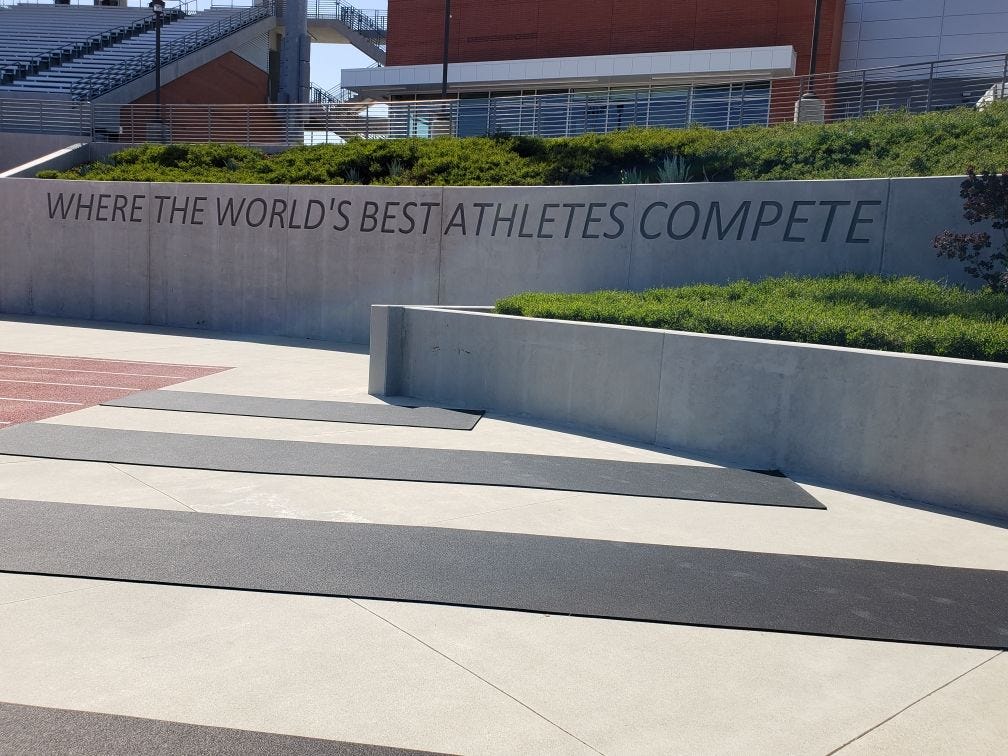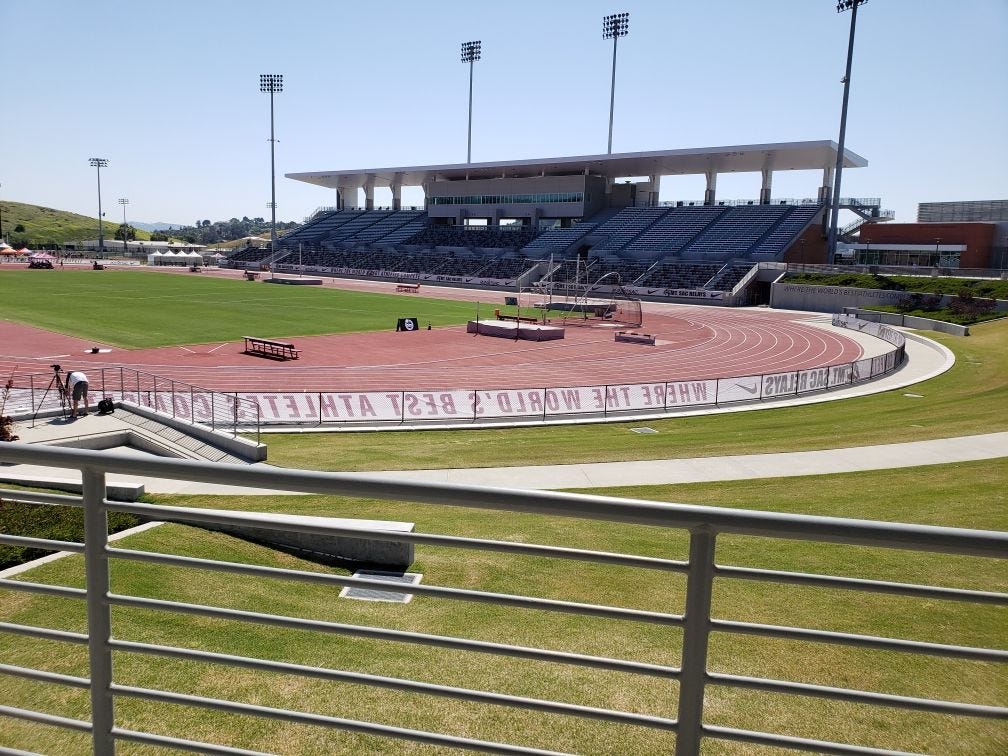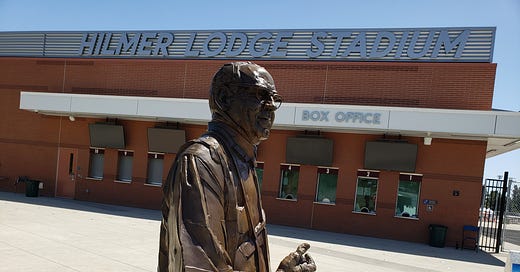Back where I belong
Covering the Mt. SAC Relays was a spring tradition when I was at the L.A. Times

I am happy to say I was reacquainted with an old friend on Wednesday afternoon after nearly two decades apart.
I aged a bit during the 18 years since I last saw him, but he looked better than ever. He had a newness and shine that glistened under the clear skies in Walnut, California, and his lines were cleaner and leaner than before.
As if that wasn’t enough, a statue of his human likeness was unveiled in conjunction with a ribbon cutting ceremony for Mt. San Antonio College’s Heritage Hall building just north of the school’s track.
My old friend is Hilmer Lodge Stadium, home of the Mt. SAC Relays.
Lodge was a journalism professor and cross-country and track and field coach at the school who was instrumental in the inception of the meet in 1959. He wanted to bring a world-class relay meet to the West Coast and he quickly succeeded in doing so as an incredible seven world records were set in the 1960 affair.
I covered the multi-day meet annually from 1986-2004 when I was a sportswriter at the Los Angeles Times. (I’ve written before about how much I loved my job at the Times, being that in my youth I was a sports nut who transitioned into track fanatic, but I never once regretted my decision to step away from it to be around for my kids.)
Now I’m back as the creator of Track & Field Informed with Johnny O to enjoy some good old-fashioned face-to-face conversations and coverage of the Mt. SAC Relays, which began Wednesday with the first day of the decathlon and heptathlon and run through Saturday. I’ll be doing the same with the Penn Relays in Philadelphia from April 28-30.

As often happens with good friends, being at Mt. SAC feels like I’ve never been away.
Junior Ayden Owens of the University of Arkansas led the decathlon after the first five events on Wednesday with 4,483 points. He was followed by senior Hakim McMorris of Cal Berkeley with 4,444 points and sophomore Austin West of Iowa with 4,343.
Owens, runner-up in the NCAA championships last year, was awarded 1,030 points when he ran 10.27 seconds in the 100 to start the day, and he tallied 1,002 points when he concluded the day with a 46.12 effort in the 400.
Both marks were the best ever recorded by a collegiate athlete in a decathlon.
McMorris and West also produced their biggest point totals in the 100 and 400.
McMorris ran 10.42 in the 100 and 46.36 in the 400. West clocked 10.65 in the 100 and 46.45 in the 400.
In the heptathlon, Senior Ida Eikeng of the University of Washington was the first-day leader with 3,598 points. She was followed by senior Allie Jones of Stanford with 3,552 points and junior Avery McMullen of Colorado with 3,459.
Eikeng, fifth in the NCAA Championships last year, had her best performances in the 100 hurdles (13.72) and 200 (wind-aided 24.09).
So did Jones, who ran 13.45 in the 100 hurdles and 24.30 in the 200. McMullen also scored her highest points in those events with times of 13.72 and 24.27, respectively.
My mind has been going back to a slew of outstanding performances I witnessed over the years at Mt. SAC.
One of the most memorable ones occurred in 2003 when then-senior Allyson Felix of L.A. Baptist High School in the San Fernando Valley set a national high school record of 22.51 in winning the invitational section of the women’s 200 while running against a high-caliber field that included 1999 World champion Inger Miller.
Felix, who has become the most decorated athlete in track and field history by winning 11 medals – including seven gold – in five Olympic Games, and 16 medals – including 11 gold – in nine World Championships, announced on Wednesday via Instagram that this will be her final year of competition.
Another one of my favorite Mt. SAC Relays memories occurred in 1982, before I was a sportswriter with the Times. I attended the meet during my final semester as a student at California State University, Northridge, after hearing great things about the Distance Carnival, which was held at night and attracted world- and national-class runners in bunches.
I expected to see some fine performances, but I was blown away when four runners ran between 27 minutes 36.2 seconds and 27:38.6 in the men’s 10,000 meters.
Times such as those might not be impressive by today’s standards, but they were very notable back then as Kenyan Henry Rono held the world record at 27:22.5.
Although I cannot recall the splits for the race, which I meticulously jotted down on a notepad, I remember the first two or three kilometers were run at a solid clip and each ensuing kilometer got faster.
Gabriel Kamau of Kenya won the race in 27:36.2 and he was followed by American Mark Nenow (27:36.7), and Tanzanians Gidamis Shahanga (27:38.1) and Zakariah Barie (27:38.6).
Those performances moved them to 11th, 14th, 16th, and 21st on the all-time world performer list at that time, and were even more noteworthy because they were produced by runners who were relatively unknown before the race.
Shahanga had run 28:12.6 in finishing second at Mt. SAC the previous year to rank 35th on the yearly world performer list. But none of the other three made the top 100 list which cut off at 28:41.8.
Nenow, who had run 28:45.86 to win the U.S. - Soviet Union dual meet in Leningrad in 1981, would set an American record of 27:20.56 in 1986. But Kamau, Shahanga and Barie never topped the times they ran that night.

The multi-events on Wednesday marked the first time since 2015 that the Mt. SAC Relays had been held at Mt. San Antonio College.
The meet was held at Cerritos College in Norwalk in 2016, and at El Camino College in Torrance from 2017-19 as the track and the field at Mt. SAC were basically torn down and re-built from the ground up.
The Relays were scheduled to return to Mt. SAC in 2020, but were canceled due to the start of the COVID-19 pandemic. They were again put on hold last year due to an upsurge in cases in Southern California, although the USA Track & Field Golden Games & Distance Open were held at the facility in May, with spectators limited to a small number of family members and friends of participating athletes.
Wednesday saw a smattering of fans in attendance. But they will increase on Thursday with the final day of the decathlon and heptathlon, qualifying in the collegiate-open men’s and women’s shot put and discus, and the first of two evenings of Distance Carnival action.
On Friday, field events will start at 10 a.m., with track events beginning at 11.
The meet will conclude on Saturday, with numerous Olympic and World Championship medalists scheduled to compete during USA Track & Field’s Golden Games portion of the proceedings.
The first events will start at 9 a.m., with the final event, the second seeded section of the high school boys’ 6,400-meter relay, scheduled to start at 8:15 p.m.
As for me, I admit to becoming teary-eyed when I walked into Hilmer Lodge Stadium on Wednesday. After 18 years away, I felt like I was back where I belonged, preparing to cover a meet that provided me with so many awe-inspiring memories over the years.




'82 was your first-ever Distance Carnival?!? I was there that night!